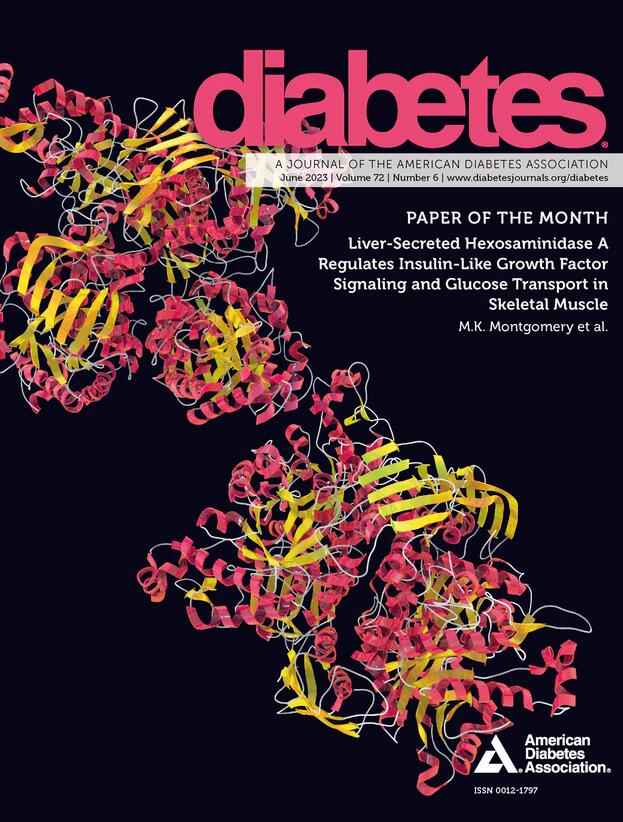205-OR:黏附相关巨噬细胞通过Cav-1依赖性调节代谢稳态
IF 7.5
1区 医学
Q1 ENDOCRINOLOGY & METABOLISM
引用次数: 0
摘要
前言与目的:脂肪组织巨噬细胞(ATMs)在调节脂肪组织功能中的作用已被证实。然而,我们的研究揭示了先前被忽视的巨噬细胞粘附脂肪细胞亚群,我们称之为粘附相关巨噬细胞(ARMs)。方法:建立了一种分离ARMs和non-ARMs的方法。分析分子和功能差异,并利用Cav-1敲除小鼠研究ARMs在代谢中的作用。结果:我们的研究结果表明,在肥胖期间,ARMs构成了atm的主要扩展亚群,表现出更高的粘附、增殖和脂质处理能力。值得注意的是,ARMs可以通过一个关键的功能标记Caveolin-1来表征。免疫细胞中Caveolin-1的基因消融显著降低了ARM的丰度,破坏了它们的粘附能力和脂质含量,导致脂肪细胞肥大、脂肪组织扩张和葡萄糖稳态受损。将瘦小鼠的ARMs重新引入eWAT可减轻肥胖引起的脂肪组织炎症和胰岛素抵抗。结论:我们的研究揭示了一个以前未被发现的巨噬细胞亚群ARMs,揭示了肥胖诱导的胰岛素抵抗的潜在治疗靶点,并为在其他组织和疾病中发现类似的范式开辟了途径。胡伟:没有。邓:没有。国家重点研发计划项目(2020YFA0803604和2023YFC3603404),国家自然科学基金重点项目(82130024),国家自然科学基金国际合作与交流基金项目(8231101033)。本文章由计算机程序翻译,如有差异,请以英文原文为准。
205-OR: Adhesion-Related Macrophages Regulates Metabolic Homeostasis through Cav-1 Dependency
Introduction and Objective: The significance of adipose tissue macrophages (ATMs) in regulating adipose tissue function is well-established. However, our investigation revealed a previously overlooked subpopulation of macrophages adhered to adipocytes, which we term adhesion-related macrophages (ARMs). Methods: We developed a method to isolate both ARMs and non-ARMs. Molecular and functional differences were analyzed, and Cav-1 knockout mice were utilized to study the role of ARMs in metabolism. Results: Our findings demonstrate that ARMs constitute the predominant expanded subpopulation of ATMs during obesity, exhibiting heightened adhesion, proliferation, and lipid-processing capacities. Notably, ARMs can be characterized by a key functional marker, Caveolin-1. Genetic ablation of Caveolin-1 in immune cells significantly diminishes ARM abundance, disrupting their adhesion capacity and lipid content, leading to adipocyte hypertrophy, adipose tissue expansion, and impaired glucose homeostasis. Reintroducing ARMs from lean mice into eWAT mitigate obesity-induced adipose tissue inflammation and insulin resistance. Conclusion: Our study uncovers a previously unexplored macrophage subpopulation, ARMs, revealing potential therapeutic targets for obesity-induced insulin resistance and opening avenues for identifying similar paradigms in other tissues and diseases. Disclosure W. Hu: None. T. Deng: None. Funding National Key R&D Program of China (2020YFA0803604 and 2023YFC3603404), the Key Program of the National Natural Science Foundation of China (82130024), the Fund for International Cooperation and Exchange of the National Natural Science Foundation of China (8231101033).
求助全文
通过发布文献求助,成功后即可免费获取论文全文。
去求助
来源期刊

Diabetes
医学-内分泌学与代谢
CiteScore
12.50
自引率
2.60%
发文量
1968
审稿时长
1 months
期刊介绍:
Diabetes is a scientific journal that publishes original research exploring the physiological and pathophysiological aspects of diabetes mellitus. We encourage submissions of manuscripts pertaining to laboratory, animal, or human research, covering a wide range of topics. Our primary focus is on investigative reports investigating various aspects such as the development and progression of diabetes, along with its associated complications. We also welcome studies delving into normal and pathological pancreatic islet function and intermediary metabolism, as well as exploring the mechanisms of drug and hormone action from a pharmacological perspective. Additionally, we encourage submissions that delve into the biochemical and molecular aspects of both normal and abnormal biological processes.
However, it is important to note that we do not publish studies relating to diabetes education or the application of accepted therapeutic and diagnostic approaches to patients with diabetes mellitus. Our aim is to provide a platform for research that contributes to advancing our understanding of the underlying mechanisms and processes of diabetes.
 求助内容:
求助内容: 应助结果提醒方式:
应助结果提醒方式:


